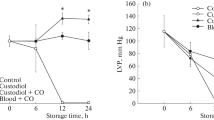Abstract
Brief perfusion with Collins' C4 solution is commonly employed for hypothermic storage of kidneys for short periods, but the mechanism of action has never been satisfactorily explained. In the studies described in this report, an attempt was made to discover the essential ingredients so that a more reproducible solution could be formulated. Rabbit kidneys were excised, infused with a number of test solutions, stored at 4°C, and then autografted into recipients in which a contralateral nephrectomy had been performed. Starting with a buffered balanced salt solution, it was found that increasing the osmolality with glucose produced a dramatic improvement in function, while replacing half of the chloride by sulfate produced a further small improvement. The other changes were either deleterious (increasing potassium or magnesium concentration) or had no effect (reducing ionic strength). It is concluded that the benefit conferred by these solutions during storage is unrelated to intracellular ionic composition but is due to the inclusion of impermeant solutes to raise total osmolality.
Résumé
On utilise couramment, pour conserver des reins en hypothermie pendant des périodes de courte durée, une perfusion rapide par la solution de Collins C4. Mais le mécanisme d'action de cette solution n'a jamais été expliqué de façon satisfaisante. Nous avons, dans la présente étude, tenté de définir les composantes essentielles de la solution, pour obtenir un liquide de conservation mieux reproductible. Des reins de lapin ont été prélevés, perfusés avec diverses solutions, conservés à 4°C et réimplantés après néphrectomie controlatérale. En commençant avec une solution tamponnée isotonique, nous avons constaté que l'augmentation de l'osmolarité par addition de glucose entraîne une remarquable amélioration de la fonction rénale; en remplaçant la moitié du chlore par du sulfate, on améliore encore, mais modérément, le résultat fonctionnel. Les autres changements de composition ont un effet délétère (augmentation des concentrations de potassium et de magnésium) ou sont inefficaces (réduction des concentrations ioniques). L'effet bénéfique de ce type de solution est donc indépendant d'une composition ionique de type intracellulaire et résulte de l'augmentation de l'osmolarité totale.
Similar content being viewed by others
References
Collins, G.M., Bravo-Shugarman, M., Terasaki, P.I.: Kidney preservation for transportation. Lancet2:1219, 1969
Keeler, R., Swinney, J., Taylor, R.M.R., Uldall, M.B.: The problem of renal preservation. Br. J. Urol.38:653, 1966
Collins, G.M., Halasz, N.A.: Forty-eight hour ice storage of kidneys: importance of cation content. Surgery79:432, 1976
Kreis, H., Lacombe, M., Ciancioni, C., Marinov, V.: 48-hour kidney preservation (initial perfusion with potassium and magnesium-rich solution). Rev. Eur. Etudes Clin. Biol.17:192, 1972
Green, C.J., Pegg, D.E.: A comparison of non-perfusion and perfusion methods for preservation of rabbit kidneys. In Organ Preservation, D.E. Pegg, editor. Edinburgh, Churchill Livingstone, 1973, pp. 16–29.
Hartley, L.C.J., Collins, G.M., Clunie, G.J.A.: Kidney preservation for transportation. Function of 29 human-cadaver kidneys preserved with an intracellular perfusate. N. Engl. J. Med.285:1049, 1971
Tanaka, N., Stevens, L.E., Terasaki, P.I.: Storage and transport of 83 human kidneys by simple hypothermia. Transplantation12:348, 1971
Acquatella, H., Pérez-González, M., Morales, J.M., Whittembury, G.: Ionic and histological changes in the kidney after perfusion and storage for transplantation. Transplantation14:480, 1972
Downes, G., Hoffman, R., Huang, J., Belzer, F.O.: Mechanism of action of washout solutions for kidney preservation. Transplantation16:46, 1973
Pegg, D.E.: Discussion. In Organ Preservation, D.E. Pegg, editor. Edinburgh, Churchill Livingstone, 1973, pp. 13–14
Welch, L.T., Flanigan, W.J.: Kidney preservation. Lancet2:1444, 1973
Green, C.J.: Rabbit renal autografts as an organ preservation model. Lab. Anim.7:1, 1973
Collins, G.M., Hartley, L.C.J., Clunie, G.J.A.: Kidney preservation for transportation. Experimental analysis of optimum perfusate composition. Br. J. Surg.59:187, 1972
Fuller, B.J., Pegg, D.E.: The assessment of renal preservation by normothermic bloodless perfusion. Cryobiology13:177, 1976
Pegg, D.E.: An approach to hypothermic renal preservation. Cryobiology15:1, 1978
Pegg, D.E., Gallant, M.: Water and electrolyte contents and extracellular space of rabbit kidneys after perfusion and storage for 24 hours at 4°C. Cryobiology14:568, 1977
Pegg, D.E., Jacobsen, I.A., Walter, C.A.: Hypothermic perfusion of rabbit kidneys with solutions containing gelatin polypeptides. Transplantation24:29, 1977
Author information
Authors and Affiliations
Rights and permissions
About this article
Cite this article
Green, C.J., Pegg, D.E. Mechanism of action of “intracellular” renal preservation solutions. World J. Surg. 3, 115–120 (1979). https://doi.org/10.1007/BF01556396
Issue Date:
DOI: https://doi.org/10.1007/BF01556396




